How to Grow Carrots
This post may contain affiliate links, which means that I may receive a commission if you make a purchase using these links. As an Amazon Associate I earn from qualifying purchases.
Ever wanted to learn how to grow carrots but need help figuring out where to start? Read on for this ultimate guide to growing carrots at home. Freshly harvested carrots are so delicious that you’ll never buy them at the store again!
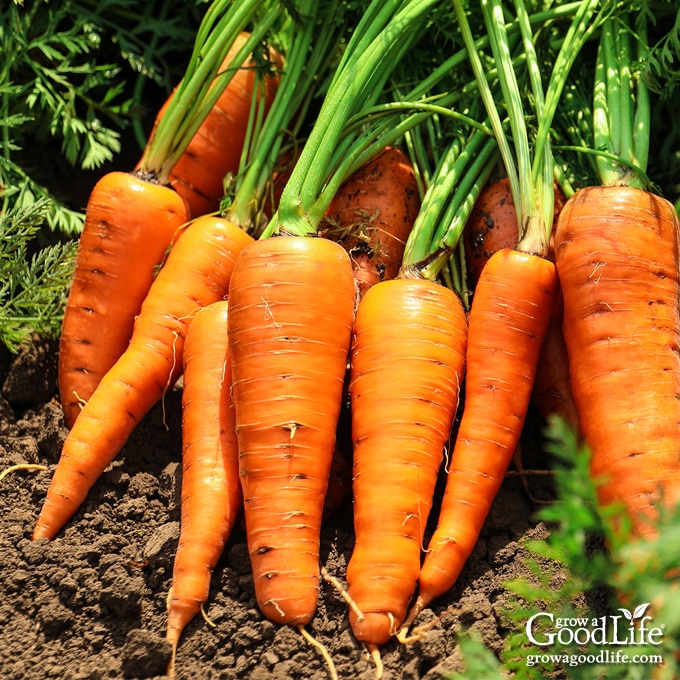
Carrots are one of the most popular vegetables and for good reasons! They are fun to grow, versatile in the kitchen, and easy to prepare for meals. Whether you eat them raw as a snack, roast them in the oven, or use them in comforting soups or stews, homegrown carrots are sure to be a hit.
While carrots often have a reputation for being difficult to grow, this is not the case. Instead, carrots need just a little extra attention at planting time and plenty of time to sprout. Anyone can learn how to grow carrots with these helpful tips!
About Carrots
The carrot (Daucus carota) has been cultivated for thousands of years and was one of the first vegetables to be domesticated. While these tasty roots are originally native to the regions of Europe and Southwestern Asia, they now grow worldwide.
Carrots are a root vegetable that is usually orange in color and has a crunchy texture. The taproot is the most commonly consumed part of the carrot, although you can also eat the stems and leaves. While the carrot is a biennial plant, it is usually harvested in the first year of growth.
Carrots are packed with vitamins, minerals, fiber, and are an abundant source of vitamin A, which can help improve vision and prevent age-related decline. They are also a good source of antioxidants that protect the body from damage caused by free radicals.
Common Types of Carrots
There are so many carrot varieties to choose from for your home garden. While orange carrots are the most popular, there are also colored varieties that will produce yellow, red, white, and even purple roots!
Carrots come in different lengths, from 2 to 10 inches. Some taste sweet and are perfect for eating raw, while other varieties are suitable for storing for a long time in a root cellar or cold area during winter.
Carrots are generally classified by the shape of their roots, and usually fall into one of four cultivars:
Chantenay
This carrot type produces short, stout roots wide at the top and tapers towards a blunt, round tip. The 6-inch conical roots grow more easily through heavy soil than other varieties. Chantenay carrots are delicious for fresh eating and a good choice for freezing, canning, and storing. Varieties include Carson Hybrid, Hercules, Red Cored Chantenay, and Royal Chantenay.
Danvers
Danvers is a medium-length carrot with a wide top that tapers to a pointed, slender root that can reach about 7–inches long. This is the variety that my grandparents grew in their vegetable garden. Their roots easily penetrate through heavy, clay soils. They have a strong carrot flavor and can be used for fresh eating and preserved as frozen, canned, or storage carrots. Varieties include Danvers Half Long, and Danvers 126.
Imperator
This is the carrot variety you will likely find at the grocery store, both full-sized and whittled down as baby carrots. They have long, straight, slender roots that taper to a pointed tip. Imperator carrots require deep loose soil to grow. The sweet flavor is delicious raw, cooked, or preserved by canning, storing, or freezing. Imperator carrots are available in several cultivars that vary in size, flavor, and texture, including Atomic Red, Avenger, Imperator 58, Japanese Imperial Long, and Sugarsnax 54.
Nantes
Nantes carrots are tube-shaped, blunt-tipped, with almost the same width from top to bottom of the root. Nantes grows best in loose, well-draining soil without competition from weeds. The skin is smooth, with a sweet flavor, and crisp texture that is good for fresh eating raw or cooked, or preserved by freezing, storing, or canning. There are numerous varieties that fall into the Nantes category, including Bolero, Little Finger, Mokum, Napoli, Nelson, Scarlet Nantes, and Yaya.

In addition, most seed catalogs categorize carrots by days to maturity, color, or use, such as fresh eating, processing, or storing. Most gardeners grow early varieties in spring for summer eating and main season crops left in the ground to mature for fall harvests for preserving. Some examples include:
- Early Carrots are usually small and ready to harvest in around 60 days. Earlies are ideal for sowing in spring for a quick crop or late summer for a fall harvest before the ground is covered in snow. Varieties of early carrots include Amsterdam, Minicore, and Mokum.
- Main Crop Carrots or main season carrots can be planted in spring to mid-summer for summer to fall harvest. These usually take longer to mature and can withstand summer heat without bolting. Main season carrots include Hercules, Nantes, Naval, and Sugarsnax 54.
- Storage Carrots: While you can store many types of carrots in a root cellar or cool area for winter, some varieties are bred specifically to improve their long-term storage capabilities, including Bolero, Oxheart, and Kuroda.
- Colored Carrots are fun to grow. In addition to orange, carrots also come in purple, red, white, and yellow. They all have similar flavor and texture as orange carrots. Colored carrot varieties include Amarillo, Atomic Red, Dragon, Lunar White, Purple Haze, White Satin, and Yellowstone. You can also buy a mix of different colors that are packaged together and have the same maturity rate, such as Calliope Blend, Rainbow Mix, and Starburst Carrot Blend.
- Short and Baby Carrots: True baby carrots are small mini carrots that are harvested young for their sweet, fresh flavor. Some are rounded ball-shaped, while some grow short tapered roots. Short carrots are ideal for growing in containers, indoors under lights, or in heavy or poor soil in the garden. Baby carrot varieties include Adelaide, Atlas, Bambino, Little Finger, and Tonda di Parigi

Tips for Growing Carrots
Carrots grow best in a sunny location with at least 6 to 8 hours of sun daily. The soil should be loose and well-draining so the roots can penetrate it easily. Here are tips for growing carrots.
When to Plant Carrots
Carrots are a cool-season crop that can tolerate light frosts. Plan to grow carrots during the cool gardening seasons of early spring and fall.
The time to start your seeds will depend on your last frost date. This is the average date of the last expected frost for your area. You can find your estimated last frost date by contacting your local extension office or entering your zip code here at PlantMaps.com.
For spring and early summer harvests, begin sowing your carrot seeds about 2 to 3 weeks before your last spring frost date once the soil temperature has warmed to at least 40˚F and can be easily worked.
What you’re aiming for is soil that has drained and dried off after the winter snow has melted. If you take a handful of soil and squeeze it, the clump should hold together without any extra moisture dripping out. If you wiggle your fingers a bit, the clump should easily crumble. If your soil is too wet, wait a few days longer, and check again. Seeds planted in wet soil will rot. You can learn more about troubleshooting carrot seed germination in this article: Tips for Germinating Carrots
The best germination rate occurs when the soil temps have reached 55˚ to 65˚F. Avoid planting your carrots in soil that exceeds 75˚. High temperatures result in poor germination, low yields, and bitter carrots.
Start sowing your carrot seeds about 10 weeks before the first winter frost date for a fall harvest. You want to give your seeds enough time to turn into fully formed carrots before the fall frost and snow wipes out your garden.
How to Prepare the Garden Bed
Carrots grow their best in light, sandy, loamy soil high in organic matter. Loose soil is vital to ensuring a perfectly straight carrot. Heavy, compacted soil is the number one cause of forked and malformed carrots.
Before sowing your seeds, prepare your garden beds by removing weeds and loosening the soil deeply with a digging fork. Then, enrich the soil with mature compost and a balanced organic slow-release fertilizer.
Carefully inspect your soil as you work it, and remove rocks, sticks, and other large pieces of material. Eliminating obstacles will give your carrots a light, easy pathway to growing to their full potential!
If the weather is dry, give the beds a good soak the day before you plan to sow your seeds.
Giving your carrots enough room in the garden bed is also vital to their growth. Please ensure that your garden bed is at least 10 to 12 inches deep.
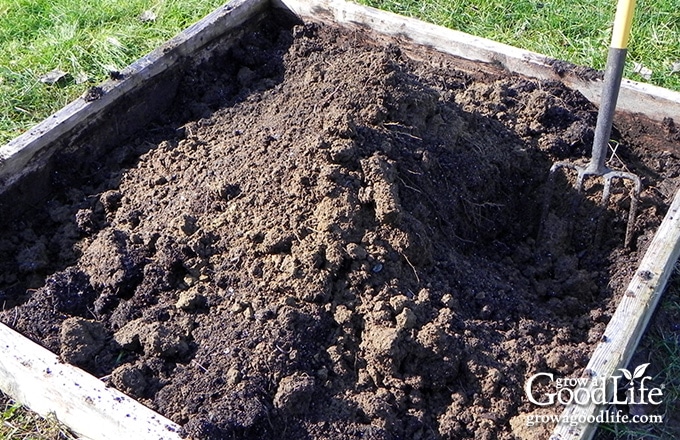
Planting Carrot Seeds
Since carrots have a long taproot, they don’t transplant well. When planting carrots, direct sow seeds in the garden or container where they will grow.
Carrot seeds can be difficult to space out properly since they are so small. Pelleted seeds are coated with a layer of clay to increase their size for easier handling. In addition, consider creating homemade seed mats to evenly space the seeds, make sowing easier, and eliminate thinning later.
Sow your carrot seeds thinly over the surface of the soil or in shallow furrows, and cover lightly with soil. It can be very easy to suffocate your carrot seeds by planting them too deep. Make sure to give them a light dusting of soil, just enough to cover the seeds. Water well, and keep the soil moist until the seeds sprout. Learn more about sowing seeds in this article: How to Direct Sow Seeds in the Garden
It takes 14 to 21 days for the carrot seeds to sprout. Succession sow or plant another round of carrots every 2 to 3 weeks for a continuous harvest.
How to Care for Carrots
Carrots are fairly easy to care for once they become established, but there are a few things you need to know to keep the plants healthy and help them thrive.
Watering
Carrots should receive about 1-inch of water per week, either naturally from rain or by watering by hand. First, check the soil moisture by poking your finger several inches deep. If the soil is dry, give your carrots a good watering.
Moisture fluctuations can slow growth and trigger the roots to fork and crack. You’ll need to hand water if you are not getting enough rain. Aim for once-a-week watering for heavy soils and twice a week for sandy soils to help keep the soil evenly damp.
Thinning the Plants
Once the carrots are several inches high, thin the plants so that each seedling is spaced about 2 to 3-inches apart. Damp soil will help the roots slide out easier, reducing the risk of disrupting the other plants.
Keeping Up with the Weeds
Make sure to weed your carrots frequently. Too many weeds can cause carrots to struggle as they grow deeper into the soil. Pluck weeds gently from your garden so as not to disturb any growth. Learn more Tips for Controlling Weeds in the Garden.
Mulching the Soil
I highly recommend mulching your carrot patch. Once the carrot seedlings are established, add a layer of mulch on the soil surface, keeping it a few inches away from the stems of your seedlings, so it doesn’t smother the plants.
Mulching has many benefits, including moisture retention, temperature regulation, and weed deterrent. Mulch can come in many forms, such as shredded paper, straw, or dried shredded leaves. Learn How Organic Mulch Helps Your Garden.
Fertilizing
Once the carrot seedlings reach about 4-inches tall, feed with a balanced organic granular fertilizer or one low in nitrogen. Too much nitrogen increases foliage production, promoting growth in the carrot tops, not the roots.
Succession Sowing
Sow another round of carrot seeds every 3 weeks for a continuous harvest until the weather warms. Carrot seeds will not germinate in temperatures above 75˚F, so stop spring sowings once the summer heat hits.
Begin sowing carrots again in late summer for fall harvests starting about 10 weeks before your first fall frost date. Succession sow every 3 weeks up to your area’s last expected frost date. Learn 3 Succession Tips to Maximize Your Harvest.
Extending the Harvest
Carrots are hardy and can survive temperatures as low as 20˚F. Carrots can remain in the ground through frost, but be sure to harvest before the ground freezes. The carrots are difficult to remove once the ground is frozen. To make harvesting easier, you can add a mulch layer to protect the carrots’ tops and help prevent the soil surface from freezing.
Light frosts will not harm established carrot plants, but young seedlings may be vulnerable. Cover the plants with a frost blanket or row cover to protect them during a cold snap. Also read How to Protect Plants from Frost for more tips.
How and When to Harvest Carrots
For most varieties, you can begin to harvest carrots for fresh eating between 2 to 3 months after sowing the seeds. Examining the top of the root is the best way to determine if a carrot is ready.
On average, a carrot should be about as wide as your thumb. Of course, size varies between different cultivars. Carrots taste sweeter when they’re smaller, so don’t fret if you don’t have enormous carrots. They’ll be delicious even when they’re small!
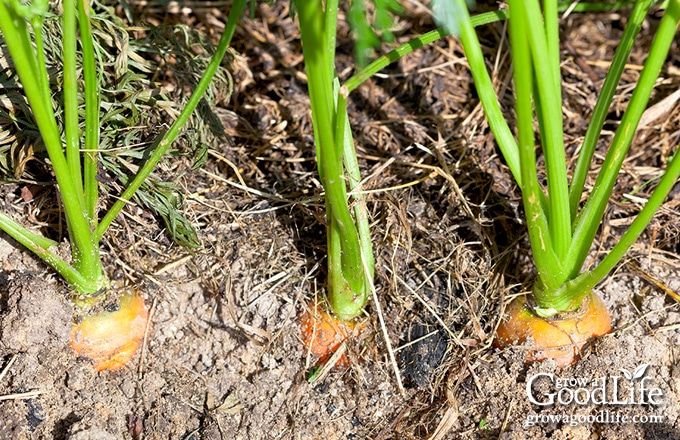
Harvest carrots in the morning while the ground is still cool. Young carrot roots should easily pull out from the soil. Give the greens a firm hold and twist as you pull them up from the ground.
Longer, more mature carrot roots are a little more difficult. Harvesting with the help of a garden fork is effective in digging your carrots out of the soil. Use the digging fork to loosen the soil under the roots, and gently pull the carrots out of the ground.
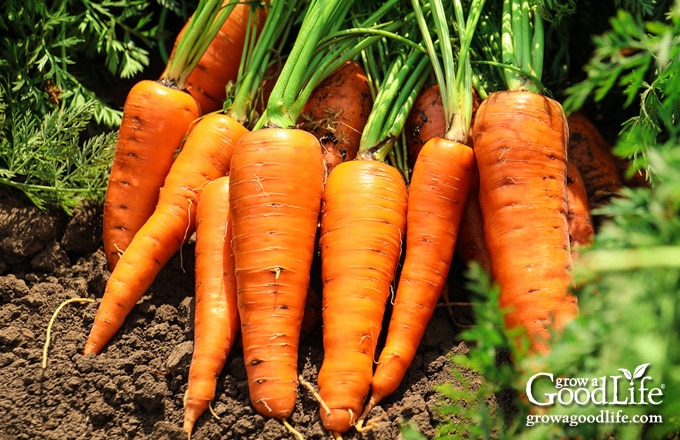
I recommend eating freshly harvested carrots as soon as possible. Over time, the sugars in the carrots diminish, causing them to lose their natural sweetness. However, if you have a surplus of carrots, they are easy to store in your refrigerator, or preserve for later by freezing, canning, or storing in a cool area or root cellar.
Growing Carrots in Containers
If you are short on gardening space, carrots can be grown in various containers. The advantages of growing carrots in pots are that you can move them around as needed, so they get full sun, and containers won’t require as much weeding as traditional garden carrots.
The key is to choose the right carrot to match the container. If you use a pot at least 12 inches deep and 12 inches wide, you can grow longer carrots. If all you have are shallow pots, stick to the shorter varieties. Check out this article on Growing Vegetables in Containers for more detailed information.
Choose a good-quality potting mix suitable for growing vegetables in containers. Sift the soil mix first if it has any chunks or wood chips. Mix in a balanced slow-release organic fertilizer, and then hydrate the soil by letting it soak for several hours. Fill the pot once the soil is evenly damp.
Scatter the seeds, cover with soil, firm in gently, and water in well. Keep the soil evenly moist until the seeds sprout and the carrots become established. Then let the soil dry out a bit in between, watering only when the top inch of soil is dry.
Once the greens are about 5 inches tall, thin the plants, so they are spaced to one plant every 2 inches. Feeding every 2 weeks with a balanced organic liquid fertilizer such as fish and seaweed emulsion will keep your plants nourished. Harvest your carrots once they reach a usable size, and sow more seeds every 2 weeks.
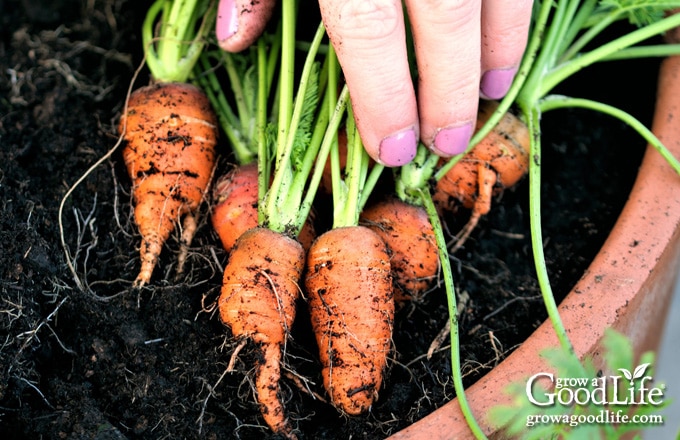
Growing Carrots Indoors
Growing carrots indoors in containers under lights is a great way to have a steady supply of baby carrots all year. A medium-sized container about 8-inches deep will grow plenty of baby-sized carrots.
Fill the pot with a damp potting mix suitable for containers. Mix in a balanced slow-release organic fertilizer, and sow your seeds. Water the plants regularly, thin as needed, and wait until the roots are big enough to harvest.
Troubleshooting Pests and Diseases
When growing carrots, be on the lookout for pests and diseases. Here are some tips to help troubleshoot some of the problems you may encounter when growing carrots:
Common Pests
Aphids, leaf miners, caterpillars, slugs, grasshoppers, and other insects may chew on the foliage. While wireworms, weevils, and voles can damage the roots beneath the ground. Most cause minor damage. Cut and destroy affected foliage, discard damaged roots, and control weeds to keep the population down. Covering the bed with a floating row cover right after the seeds germinate can control most flying pests.
- Carrot Rust Fly: Carrot rust flies appear as small flying insects that attack your taproot vegetables, such as parsley, parsnips, and carrots. Symptoms of carrot rust flies include wilted greens with stunted growth and tunneling in the root with rust-color excrement left behind by the flies. Using row covers is an effective method of deterring flies from devastating your carrot crops. You can purchase row covers at any garden retailer or make your own using hoops and mesh netting.
- Flea Beetle: Flea beetles are small black and beige beetles that attack the foliage of your carrots. They leave behind noticeable holes in the leaves of the foliage. While flea beetles affect most garden vegetables, a large infestation will slow the overall growth of carrots. Using row covers is an effective barrier to prevent flea beetles from making their way into your carrots.
- Wire Worm: Wireworms are the larvae of click beetles. The worms can cause severe damage to carrots by creating tunnels through the roots as they feed. To reduce wireworm problems, maintain healthy soil, practice good sanitation and remove infected roots and foliage, rotate your crops with non-host species, and turn the soil to expose the wireworms to birds or chickens to help keep the population down.
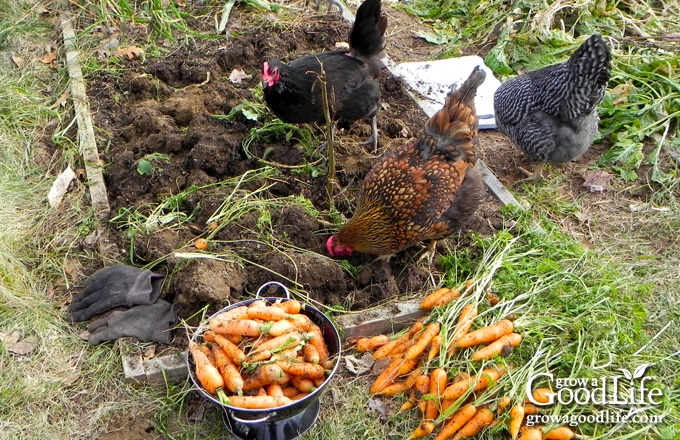
Common Diseases
Many fungal and bacterial diseases can infect both the roots and the greens. Foliar diseases can destroy the greens, reducing photosynthesis, while root diseases caused by soil-dwelling organisms can infect the root. The best way to prevent these diseases from reoccurring is to remove the affected plants, practice good soil hygiene, and use crop rotation. Try growing disease resistant varieties if you discover persistent carrot infections in your garden. If you discover persistent carrot infections in your garden,
- Aster Yellow Disease: Aster yellows is a common bacterial disease that can affect your carrots. Signs of aster yellow disease include short and distorted carrot tops and thin, hairy roots. Carrot roots that are affected by aster yellow disease also have a bitter taste. Unfortunately, there is no cure once plants are infected. Since the disease needs live plant tissue to survive, killing the plants will stop the spread. Remove diseased plants from the garden and burn or bury them deep underground. Leafhoppers and other flying pests can spread aster yellow disease as they travel from plant to plant. You can prevent the disease by using floating row covers and regularly weeding your carrots.
- Black Canker: Black canker is a fungal disease that is as nasty as its name implies. It appears on the crown and shoulders of your carrots as shallow, brown/black cankers. In addition, the foliage develops brown spots all over. Luckily, there are options to prevent black canker from appearing. First, cover the shoulders of your carrot roots with extra soil. Second, there are cultivars of carrots specially bred to resist black canker disease.
How to Preserve Carrots
Freshly harvested carrots will last several weeks stored in the refrigerator. After harvesting, slice off the tops and give your carrot roots a good scrub under cold water to remove dirt.
Let the carrots air dry, place them in a plastic bag, and store them in your refrigerator’s crisper drawer to help retain their delicious flavor.
You can keep the carrot tops, as they are also edible. Or they make a great addition to your compost bin if you don’t care for carrot tops.
Here are several ways to preserve carrots longer:
Freezing Carrots
Blanching and freezing carrots is a great way to preserve your carrot harvest. Having plenty of carrots in the freezer makes it so easy to use them in cooked recipes because the prep work is already done. Learn how to freeze carrots with this easy step-by-step guide: How to Freeze Carrots.

Canning Carrots
Canning carrots is a great way to preserve them. Pressure-canned carrots are shelf stable and can be prepared quickly for meals. Since the canning process cooks them, they only need 10 minutes on the stove to heat up. This step-by-step pressure canning tutorial will show you how to safely can carrots: How to Can Carrots.
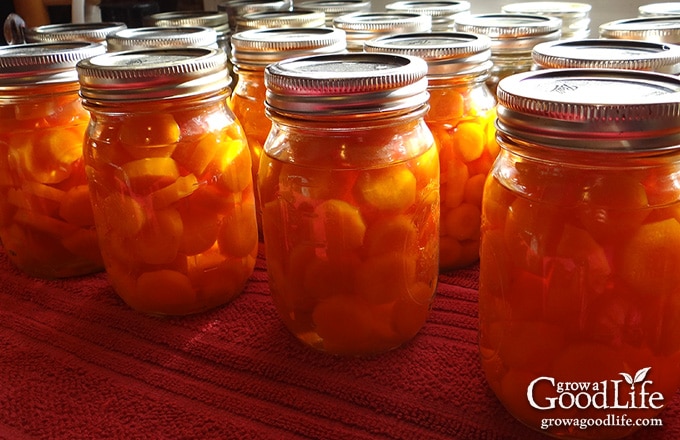
Storing in a Root Cellar
Like most root vegetables, the flavor of carrots sweetens after a frost. For carrots grown for winter storage, let carrots remain in the ground for a few light touches of frost, but be sure to harvest before the ground freezes. Dig up the carrots, and trim off greens to 1-inch. Brush off the loose soil, but do not wash. Store only good-quality roots without any bruising, splits, or damage.
Store carrots in buckets, boxes, or totes packed with damp sand or sawdust. Sort the carrots by size, and layer the carrots starting with the largest roots on the bottom so you can use up the smaller ones first. Cover each layer with about 1/4-inch of sand or sawdust, and add a final layer of 2-inches on top. Ideal storage conditions are at a temperature of 32 to 35˚F and 90% relative humidity. Under these conditions, carrots can last up to 6 months in a cool basement or root cellar. You can learn more about storing crops in this article: 14 Crops for Winter Food Storage.
—
Carrots are a delicious, nutritious, and easy-to-grow vegetable. They can be grown in various climates and soil types, making them a perfect choice for home gardeners. I hope by following the tips in this guide, you’ll be able to grow your own bounty of carrots.
You May Also Like the Following:
Good planning is key to a successful vegetable garden
Whether you are new to growing your own food or have been growing a vegetable garden for years, you will benefit from some planning each year. You will find everything you need to organize and plan your vegetable garden in my PDF eBook, Grow a Good Life Guide to Planning Your Vegetable Garden.

